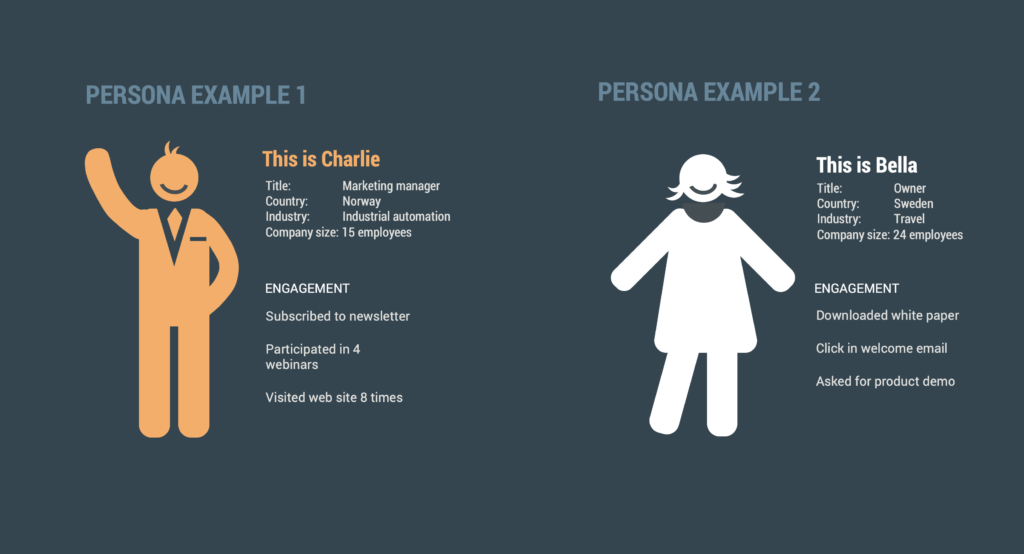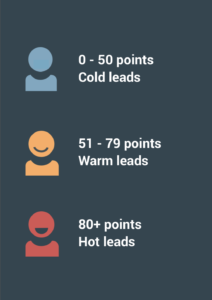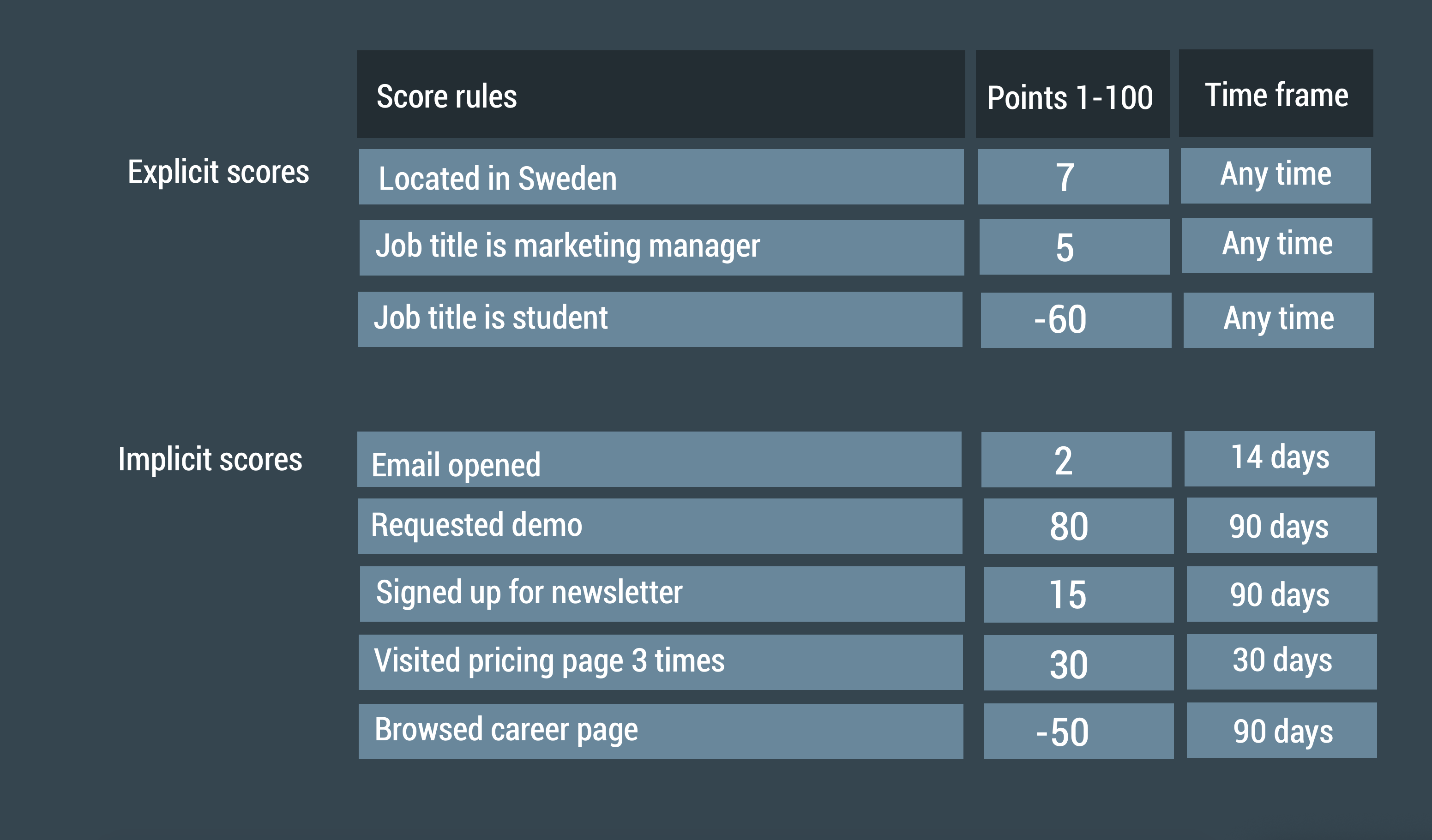To get started with lead scoring, you need to know what you want to score your leads on. There are some default score rules set up in eMarketeer to give you a head start, but lead scoring works the absolute best when it’s tailored to fit your business and sales processes. That’s why it’s important to take the time and put together your lead scoring model, and you should also do that together with your sales team as their insights are important here as well.
If you already know what you want to score your leads on, you can us this tutorial guide on how to set up your score rules in eMarketeer.
Some quick notes about lead scoring
What is lead scoring?
Lead scoring is a method used to identify marketing qualified leads (MQLs) and easily see how ready your leads are to buy from you. Lead scoring means that you assign points to your leads based on their interest in you and how well they fit your buyer persona. When the lead reaches a certain score, it’s considered an MQL and marketing can deliver them to sales. In other words, the higher the lead score, the more sales-ready the lead is.
Why use lead scoring?
- Sales and marketing alignment
Lead scoring is a joint activity between marketing and sales teams. If the lead scoring is based on insights from both teams, you ensure that no leads fall through the cracks and both teams share the same view in what qualifies a lead and which leads are ready to be handled by the sales team.
- Focus on the most relevant leads
Time is money, as they say. We don’t want to waste the sales team’s time by having them trying to sell to leads that are not ready for it yet or just not relevant at all for your business. Lead scoring is used to identify MQLs, which means that the sales team can put their time and effort into the leads that are most likely to buy at this team.
- Find the perfect timing for sales
Nobody likes to be sold to. Especially if they’re not ready for it, for example, if they visit your website for the first time or just like a post on a social media. That means that the lead has just entered the buyer’s journey and is not ready to be contacted by sales. When you build a lead scoring model that also fits the buyer’s journey, you allow the sales team to contact the lead at precisely the right timing.
3 steps to build your lead scoring model
A lead scoring model means that you determine what you want to score your leads on, how many points are required to be considered an MQL, and how many points each rule is worth.
1. What should you score on? Your customers have the answer
The first thing you need to do is to decide which rules you want to score your leads on. Which actions and attributes do you find important that a lead fulfills to be considered as qualified. There are two types of rules you can score on; implicit and explicit scoring:
Explicit scoring is based on how well the leads match your buyer persona when it comes to demographics and the company profile.
Implicit scoring means that you score based on their marketing engagement.
If we’re going to put it simply; explicit scoring is based on profile and implicit scoring is based on behavior and they are both important to qualify a lead.
Now, how do find out what to score on? Your customers sit on a lot of the answers here. Start by looking at their demographics and company profiles. Some examples of data points you could look at there are country, job titles, industry, company size, etc. The next step is to analyze their behavior. Map out which marketing content they consumed and how they engaged in it before they became a customer. What emails did they click, which web pages did they visit, what content did they download, did they attend webinars or events? Also, keep in mind what activities and campaigns you have planned in the future and what marketing engagement you find important there as well.
Don’t forget to look at the sales conversions for the data points you find as well. You probably notice that some data points are closer to a sale than others, for example, a sign up to receive a product demo probably leads to a sale more often than a sign up for the email newsletter. Look at that as well when you compile all data, it’s going to help you out in a later step.
So, to sum up. You should look at:
- You customers company profile and demographics
- Their previous marketing engagement
- The sales conversions for the actions and attributes
Use all this data you have on your customers and put together your buyer personas. Let’s say that some of the attributes your customers have look something like this:

The data points in your buyer personas, are now what you can base your lead score rules on. So the more your future leads match your buyer personas or ideal customer profiles, the more points do they get. This step of the lead scoring model is a lot about analyzing and collect data, but the more information you can compile about your customers, the better can you score your future leads. It’s worth all this data crunching, promise.
2. When is a lead considered as marketing qualified (MQL)?
When it comes to the score range, many like to use the 1-100 points range in lead scoring and that’s also the range we have in mind for the default scoring sets in eMarketeer. Others might like to use a 1-10, but the 1-100 allows you to be more finetuned and detailed in your scoring since you have more numbers to pick from. Establish the range you want to go with and decide on your sales threshold; at which score is your lead considered an MQL and ready to be handed over to sales. For example, when a lead reaches a score of 80 or more, they are considered “hot” enough contacted by sales. Both marketing and sales should be involved in deciding on this score as well so they’re all in sync when it comes to what qualifies an MQL. To make it easy to determine a lead’s “hotness,” you could set thresholds throughout your whole lead scoring range. For example:

3. Set points to each lead score rule
Now that you know which criteria to score on and which range you want to go with, you decide how many points each rule should give the lead when they fulfill the rule. A few considerations to keep in mind when you score your rules:
- Set different points to different rules
I mentioned previously that you could look at the sales conversions for your score rules, and you probably then noticed some rules lead to a sale more often than others. Those rules should then give more points to the leads. So the closer the score rule is to a sale, the higher points should it be worth. - Combine several rules into one
An email opened in itself might not be worth that many points. But, in combination with a click and several visits to a landing page, it might show some more interest. That’s why you could combine several rules into one, so the lead must fulfill them all to receive the points for that rule. - Don’t be afraid to use negative scores.
You could also find the leads that are not relevant at all for you with the help of lead scoring. You could therefore set up negative rules. In other words, rules that you don’t seem likely will lead to a sale. For example, if they have student as their job title or if they’re from a country where you can’t ship your product. When a lead fulfill a negative rule, the points will be removed from their lead score. - Consider the time frame and occurrence for engagement rules
Let’s say that you set up a scoring rule to award points when a lead clicks an email. But then time goes and you don’t see more activity from the lead. It has most likely lost interest. That’s why you might want to set up a time frame so scores are only handed out if the link click happened sometime during the past 3 months (or whatever time frame you decide on). If it’s been longer than that, the points will expire and be removed from the lead score.
You could also choose to set how many times a lead must do a specific action to get the points, for example, 3 visits to a landing page instead of just one. - You could score just by having information on the lead
Some might say that the more information you have on a lead, the more qualified they are. So when you do your explicit scoring, you don’t necessarily have to set up criteria to exactly match your buyer persona. You could just score that you have certain information on the lead. For example, a lead where you have a phone number to him/her in your database might be closer to a sale than a lead where you just have the email address. You could then give points to the lead if it’s just has a phone number on the contact card.
List your score rules, how many points they are worth, and if/when they should expire, and you might come up with a list that looks something like this:

4. Put your lead score into action
Now it’s time to put your lead score rules into action. Use the list of lead scores that you came up with and go to eMarketeer to set it up and all your eMarketeer contacts will get scored. Follow this guide and watch this tutorial on how to set up your score rules in eMarketeer.
Common lead scoring mistakes
To sum up, let’s look at the important steps that you shouldn’t do when crafting your leads scoring model:
- Leave your lead scoring model as it is
To keep your lead scoring model as accurate as possible, it needs to be constantly updated and tweaked the more you know about your customers. A good tip to see if your lead scoring needs updating is to keep an eye on if the MQLs that you hand over to sales convert to customers. If you notice that those numbers decline, it’s probably a sign that you need to tweak your lead scoring. Perhaps you know more about your buyer personas, perhaps they have shifted a bit, or perhaps you score some rules too high if the MQL is not ready to buy yet. Sync with your sales team on a timely basis and be open to the fact that you’re never quite done with your lead scoring model. - Forget about using negative scores
Lead scoring is about finding the leads that are most likely to buy from you. That also means that you can “filter out” the bad leads that are not worth making time for. Add scoring rules for undesired behavior that removes points from the score; for example, if the job title is student, if there’s a company size that’s not your target, a visit to a web page with your job listings, and so on. - Award the same points to every rule
Some marketing engagement is closer to a sales conversion than another. For example, a form submission that requests a product demo is closer to a sale than a newsletter sign-up. Have this reflect on the lead scoring as well by setting higher points for the actions and attributes that are most likely to lead to a purchase. - Not considering a time frame for your rules
Let’s say that a lead visits your pricing page on your website. Now, if that happened yesterday, that visit is absolutely relevant in qualifying the lead. But if that visit happened a year ago and there has been no action from the lead since? Well, then the lead has most likely lost interest. If you don’t consider time for your lead score rules, you will end up with leads with scores that might not be relevant to you anymore. See your lead score time frame as an expiration date for your points. For example, a web visit is only worth points if it happened sometime during the past month. When the month is up, the scores are deducted from the lead score. That way, you are sure that your lead score indicates the leads’ “sales-readiness” right now.
Good luck with creating your lead scoring model! Don’t forget that you can also use this guide of you need help with implementing your lead scoring model in eMarketeer.